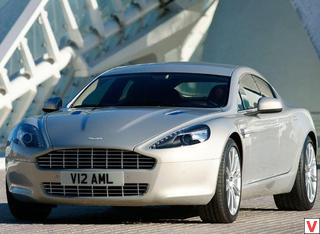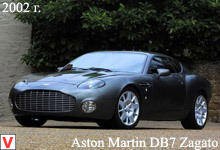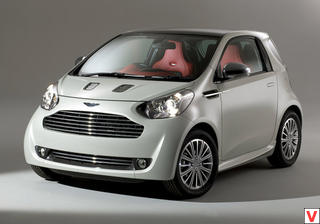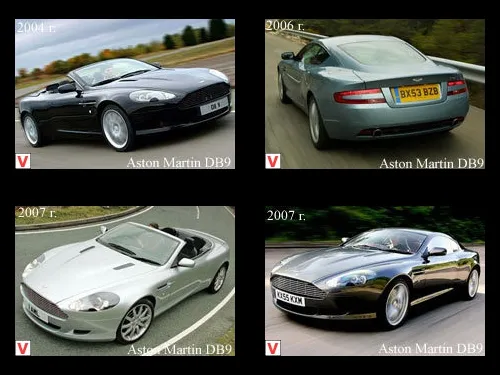
Aston Martin DB9 - the first model of the company, produced at the newest and most modern factory in Gaydon, Warwickshire county. As well as the first model built in line with the new strategy of the VH (Vertical / Horizontal) Platform, according to which all further machines of the company will be built. The developers claim that this "vertically-horizontal platform" provides for the unprecedented lightness and rigidity of the structure as a whole. With the advent of the DB9 in the history of Aston Martin, a new chapter has begun. After all, DB9 is not only the most advanced model in the company's lineup, it is the ancestor of a whole series of "mixed" British supercars.
Work on the DB9 project began in mid-2000, literally six weeks after the appointment of Ulston Bets, who had previously headed the research and development department of Porsche AG, as Aston Martin. Bez has completely revised the company's development strategy. In order for Aston Martin to make a good profit, it was necessary to create a new universal platform on which it was possible to build not one, but several models. Ulrich proposed to use a space frame made of aluminum, which by means of simple modifications lengthened or shortened, which enables to create models of different lengths.
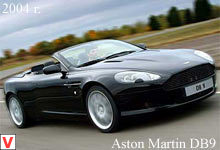
It was assumed that in addition to the general frame, the cars should have the most unified units: suspension, brakes, transmission, wiring, etc. All this will significantly reduce the time and cost of developing new products and expand the model range. The new platform is called VH (vertical / horizontal). The word vertical means “vertical integration”: the Aston Martin line will stretch up and down (both large and compact models will appear). Accordingly, horizontal is “horizontal integration”, the use of technical and intellectual resources of companies belonging to the Ford Motor Company (Volvo, Jaguar, etc.).
By September 2001, the work on the exterior of the future Aston Martin DB9 (internal designation - AM803) was completed. However, just a month before the post of chief designer Ian Callum company instead he was appointed Henrik Fisker, who previously worked in the BMW design studio. The new manager did not approve of the body look too aggressive, in his opinion, and the stylists had to tinker with the panels of an almost finished car, trying to make its appearance more balanced. Guided by the principle of "horizontal integration", the tuning of aerodynamics was entrusted to Volvo specialists.
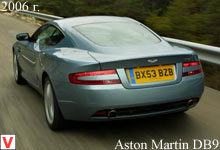
They managed to achieve an optimal distribution of incoming air flows, reduce the lift force that affects the car’s handling when driving at high speeds. Over the passive safety DB9 also worked Swedish engineers. They, in particular, selected the shape and size of the elements of the programmed deformation installed in the front part of the frame (in front of the motor) and in the frontal collision of taking on the role of “dampers”. Thanks to the original design of the doors, they open up to 12 degrees when opened. The interior of the DB9 is an example of a successful combination of traditionalism and modernity.
There is not a single shiny surface here - only brushed aluminum and wood rubbed with special oil (for better manifestation of texture). Aluminum instrument panel, bearing the engraving with the company's emblem, in addition to the four analogue scales, it accommodates a pair of high-resolution liquid crystal displays — they display the service information of the onboard computer. Around the "family" chronograph grouped on the central console remote control navigation, "climate" and having a speaker 10 audio Linn.
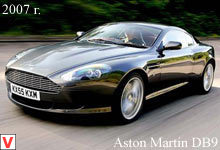
A little higher are the buttons that control the “automaton” modes (on the version with “mechanics” the lever is in the usual place); between them there is a transparent engine start button decorated with a “winged” logo. The power unit DB9 - 6-liter V-shaped "dozen", this is the third generation V12 Ford. Having installed new distribution and crankshafts, having finalized the exhaust systems, lubrication and injection control, the designers removed 450 "horses" at 6000 rpm.
and 570 Nm of torque at 5000 rpm. With this engine, the car runs at a maximum speed of 300 km / h, and acceleration to hundreds, depending on the transmission, is 4.7 seconds. (with 6-step "mechanics") or 4.9 seconds. (with a 6-step "automatic", controlled "by wire"). At the same time, the engine became very elastic: 70% of the maximum torque develops already at 1500 revolutions per minute. Powerful brakes complete the picture. The diameters of the ventilated brake discs at the front and rear are, respectively, 355 and 330 mm. Plus EBA emergency braking system.
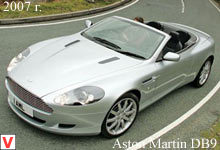
And in order not to let the car go astray, stabilizing assistants are provided - ABS, EBD, TC, DSC. When developing a new model, the designers managed to achieve an ideal mass distribution between the axles (50:50), for which the gearbox was installed directly on the leading rear axle, and the engine shifted as far as possible behind the front. KP, as already mentioned, can be automatic and mechanical. In the first case - a "machine» ZF production, in the second - Italian mechanism Graziano (KP from this company is set, for example, in Ferrari 575M). Both boxes have six steps.
To understand how structurally the DB9 differs from all previous Aston Martin, it’s enough to look at the section of the central tunnel: here is the connecting link between the rear axle and the engine - a carbon driveshaft, which weighs much lighter than steel and has less inertia. Developers are actively struggling with overweight car: not counting the frame, made of aluminum hood, roof and rear fenders. The front fenders and trunk lid are made of composite materials. All together it was possible to get a small gain in weight, compared with the Aston Martin DB7, to double the rigidity of the body and richer equip the car.
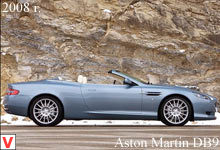
The assembly of one car takes about 200 hours. In particular, only the operation of applying the paint coating Aston Martin DB9, from preparing the surface of the body to painting itself, takes 50 hours. In 2003, the premiere of the Aston Martin DB9 coupe took place at the Frankfurt Motor Show.
Its length is 4.7 meters, and weight - 1.8 tons. Under the hood is a 12-cylinder naturally-aspirated engine with 457 horsepower. From zero to one hundred kilometers per hour, the car accelerates in 4.7 seconds, and its maximum speed is 306 kilometers per hour. The power unit is paired with an automatic transmission with manual shift. As an option, you can order a gearshift system using special levers on the steering wheel. The interior is distinguished by a stylish design, an abundance of leather and alcanthra.
The landing formula is 2 + 2, two full front seats, and two small rear seats. Start the car with a special button. The standard package includes powerful brakes, built on the basis of the Brembo components, as well as the system of course stability with sports settings.
In 2008, Aston Martin restyled the DB9 coupe and cabriolet. The most significant changes have been the interior and power unit. The engine was forced to 470 hp, while the torque increased to 600 Nm. Acceleration to 100 km / h from the updated DB9 takes 4.6 seconds. The maximum speed increased from 299 to 306 km / h. Restyled version has a new grille with five horizontal slats instead of seven.
The rear-view mirrors and the design of 19-inch alloy wheels have also changed.

